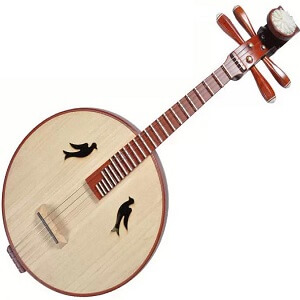Zhongruan
 Once one of China’s most ancient but extinct plucked string instruments, the Chinese ruan (moon guitar) as we know of today was developed for the modern Chinese orchestra in the 1970s. This occurred as a result of a deficiency in lower registers among plucked string instruments. Thus, the ruan - originally obsolete - was recreated to fulfill this lack of sound. Consequently, variations of the instrument - such as the gaoyin ruan (soprano ruan), xiaoruan (alto ruan), zhongruan (tenor ruan), daruan (bass ruan) and diyin ruan (contrabass ruan) - were designed based on the original.
Once one of China’s most ancient but extinct plucked string instruments, the Chinese ruan (moon guitar) as we know of today was developed for the modern Chinese orchestra in the 1970s. This occurred as a result of a deficiency in lower registers among plucked string instruments. Thus, the ruan - originally obsolete - was recreated to fulfill this lack of sound. Consequently, variations of the instrument - such as the gaoyin ruan (soprano ruan), xiaoruan (alto ruan), zhongruan (tenor ruan), daruan (bass ruan) and diyin ruan (contrabass ruan) - were designed based on the original.
Records state that, during the time of the Han Wu Di (140 BC - 87 BC), plucked string instruments such as the qin, zhu, zheng and konghou were already in use. In addition to that, the pipa - a generic term for plucked string instruments during that time - possessed a round body, straight neck, 12 frets as well as four strings. This instrument’s shape, just like today’s ruan, is believed to be one of the earliest forms of the ruan. Hence, is can be argued that the ruan was first invented during this period.